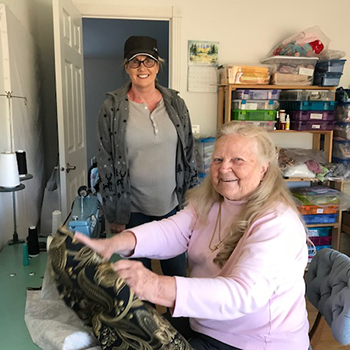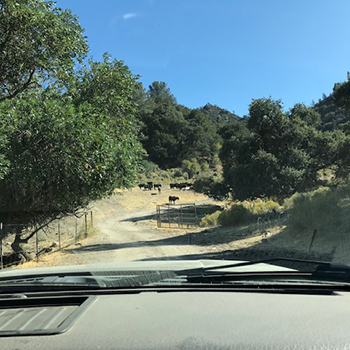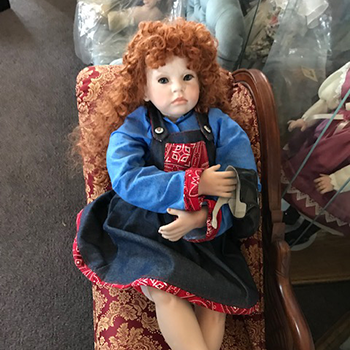By Denise Seghesio Levine | Fall 2019
I visited Ted, Marie and Janet Wyman on a breezy, end of September Sunday afternoon in Tehachapi, California. While Marie held down the fort, Ted and Janet took me on an abbreviated tour of their family’s more than 7,000 acre ranch in the Tehachapi Mountains.
We drove through lower elevations of gray sages, into a mix of evergreen and deciduous oaks and up into the towering Ponderosa and Jeffrey Pines. As we drove, Ted told me a little of the history of the property.
Ted’s great grandfather originally made his way west from Ohio after the Civil War, arriving in California sometime around 1883 or 1884. Because Ted’s great grandad had a limestone business and cement factory in Ohio, he naturally expanded his business into California. Together with his brother-in-law, they purchased land near La Jolla and Los Angeles and originally founded the Union Lime Company.
He purchased the Tehachapi property, a cement plant and quarry in Redlands and a quarry and plant in Fontana that was eventually sold to Kaiser Cement.
As evidenced by the strata of rock visible in cuts and the many huge boulders tossed about the landscape, this is a very geologically active area. Limestone deposits have been pushed up from the ocean floor, and kneaded and layered into the earth in thick ribbons, flecked with fossils and rich in the story of the earth’s formation for those who can read the signs. Ted’s great grandfather could read the signs.
On the Tehachapi property’s, Summit Lime Company, limestone (Ca CO3) was quarried, then burned in long stone kilns, and then hydrated. There were and are many commercial uses for lime. The Summit Lime Company was the major supplier for hydrated lime for whitewash and mortar for plaster and for the cement used for the aqueduct built in 1909 from Owen Lake to Los Angeles. Railroads used it for ballast along the tracks and lime was also used for refining sugar. Long rows of railroad cars would regularly wind up the state to transport hydrated lime from Tehachapi to the CH Sugar Refinery in Crockett on the San Pablo Bay. Lime was also used for processing steel, purifying water and waste water and still has many other uses. Ted estimates almost a million tons of limestone a year was mined from the quarry while it was active.
Built by Chinese workers, the kiln was marvelously fabricated from stone on the property. Ted recounted that pieces of history had been pilfered from the intricately pieced rock kiln throughout the years. Between 1903 and 1910, embedded rocks engraved with dates and events were pulled from the edifice and removed. And changes continued as the years took their toll. Before the Tehachapi earthquake the kiln boasted four (4) stacks, now one remains.
The quarry was closed a little after the depression of 1932-33. When World War II started, the majority of the mining equipment and machinery was pulled from the ranch and dismantled for scrap metal for the war effort.
Moving on we passed mule corrals where mules were housed while the quarry operated. When snow covered the landscape, wagons so large they required four to six mules to haul limestone from the quarry to town and the kilns Summit Lime had built there to keep work going during the winter.
The ranch is vast, but a cookhouse, corrals, cabins and remnants of different chapters of the ranch’s history peek around corners.
Stands of oaks, pines and redwoods and even the denuded acres scarred by fires have their stories. The last fire came through in 2015. Some oaks will survive, but the pines did not make it. Ted doubts much of the forest will regenerate where the fires went through. There was Jeffrey pine timber on the east side, blue oak, black oak, California live oak, pinyon and most never reproduced after past fires. So the topography has changed quite a bit: 1,700 acres of first and second growth have burned and do not appear to be regenerating.
Although heavily treed, the ranch was not purchased for the timber. Timber was always an afterthought. Originally timber was used to fire the kilns for the limestone and wasn’t considered for lumber. But this resulted in overcrowding in areas and the Ponderosa Pines are dense enough that at 5,500-6,000 feet, a 30-inch pine will take 160 years to grow.
In 1993, Ted was able to use a timber harvest plan in an area that partially burned and took out what he could… but the plan was thwarted and needed road work was stopped because of the regulations protecting salmon. Notable is that there are no salmon within a hundred miles??
There is a timber management plan for the property but years ago Kern County determined there was no significant privately held timber resources not owned by the state or feds, so there is no zoning in Kern County for timber, and consequently no mills.
Cattle still run, on the ranch. The Wymans have established a hunting club for hunters, a shooting range as well and have camping facilities for non-hunting visitors through HipCamp. The Wyman family also donated 600 acres to a park on the edge of the property.
In addition to stewarding and managing the ranch, the Wymans have additional divergent skills and talents. Among his other endeavors, Ted has an international background in engineering and designed major installations in far flung parts of the world. Janet was lucky to travel around the world with her dad during her school years, learning to ride horseback not on the dusty hills 6,000 feet above the Tehachapi valley, but stylishly side saddle in Saudi Arabia. Now a television producer in Southern California, Janet is next in line to take over management of the property. Ted introduced her to the successful deer hunter we ran into in camp as “the other boss.”
As the wind picked up and the day grew darker, we drove back down the mountain and I was able to explore a little of Marie’s world.
Beautifully pieced quilts drape chairs and sofas in all rooms. An organized sewing room houses her fabrics, threads, ironing boards. Marie was working on a quilt when we left for our tour, and was heading for the machine to finish a perfectly folded edge when we returned. When I admired a beautiful vintage style doll comfortably perched in a chair, Marie shared she had made the doll herself. She had learned the art while recovering from back surgery 40 years ago. A friend taught her the basics, but before long, Ted bought her a kiln and Marie was on her own. Doll making includes making and firing porcelain molds for the body and head, meticulously painting the delicate faces and hands, crafting and styling the hair and finally designing and sewing the rich
vintage costumes. Marie can do it all. Her dolls are available to visit by appointment.
Upcoming Events



